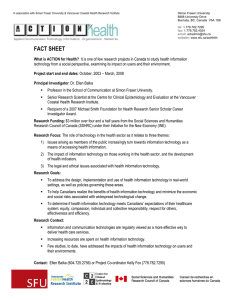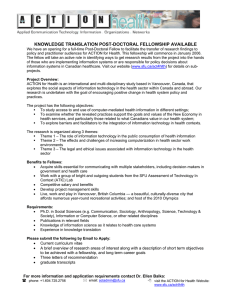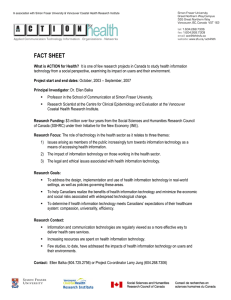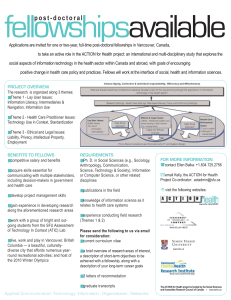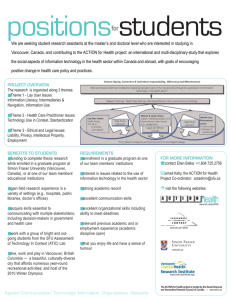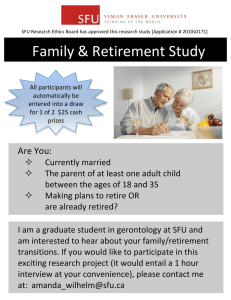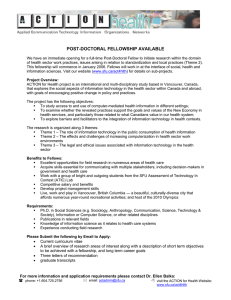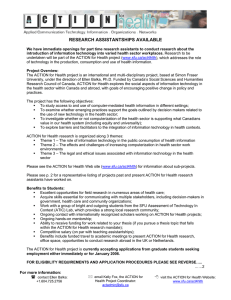T HINKING Social Justice in Health Care
advertisement
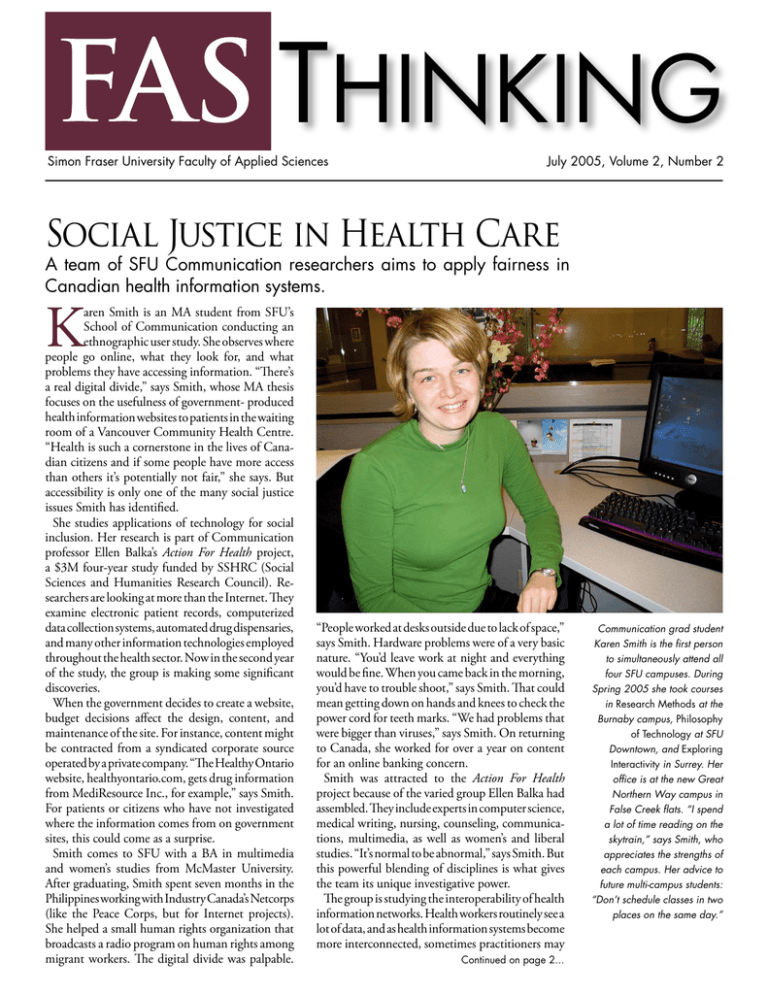
THINKING Simon Fraser University Faculty of Applied Sciences July 2005, Volume 2, Number 2 Social Justice in Health Care A team of SFU Communication researchers aims to apply fairness in Canadian health information systems. K aren Smith is an MA student from SFU’s School of Communication conducting an ethnographic user study. She observes where people go online, what they look for, and what problems they have accessing information. “There’s a real digital divide,” says Smith, whose MA thesis focuses on the usefulness of government- produced health information websites to patients in the waiting room of a Vancouver Community Health Centre. “Health is such a cornerstone in the lives of Canadian citizens and if some people have more access than others it’s potentially not fair,” she says. But accessibility is only one of the many social justice issues Smith has identified. She studies applications of technology for social inclusion. Her research is part of Communication professor Ellen Balka’s Action For Health project, a $3M four-year study funded by SSHRC (Social Sciences and Humanities Research Council). Researchers are looking at more than the Internet. They examine electronic patient records, computerized data collection systems, automated drug dispensaries, and many other information technologies employed throughout the health sector. Now in the second year of the study, the group is making some significant discoveries. When the government decides to create a website, budget decisions affect the design, content, and maintenance of the site. For instance, content might be contracted from a syndicated corporate source operated by a private company. “The Healthy Ontario website, healthyontario.com, gets drug information from MediResource Inc., for example,” says Smith. For patients or citizens who have not investigated where the information comes from on government sites, this could come as a surprise. Smith comes to SFU with a BA in multimedia and women’s studies from McMaster University. After graduating, Smith spent seven months in the Philippines working with Industry Canada’s Netcorps (like the Peace Corps, but for Internet projects). She helped a small human rights organization that broadcasts a radio program on human rights among migrant workers. The digital divide was palpable. “People worked at desks outside due to lack of space,” says Smith. Hardware problems were of a very basic nature. “You’d leave work at night and everything would be fine. When you came back in the morning, you’d have to trouble shoot,” says Smith. That could mean getting down on hands and knees to check the power cord for teeth marks. “We had problems that were bigger than viruses,” says Smith. On returning to Canada, she worked for over a year on content for an online banking concern. Smith was attracted to the Action For Health project because of the varied group Ellen Balka had assembled. They include experts in computer science, medical writing, nursing, counseling, communications, multimedia, as well as women’s and liberal studies. “It’s normal to be abnormal,” says Smith. But this powerful blending of disciplines is what gives the team its unique investigative power. The group is studying the interoperability of health information networks. Health workers routinely see a lot of data, and as health information systems become more interconnected, sometimes practitioners may Continued on page 2... Communication grad student Karen Smith is the first person to simultaneously attend all four SFU campuses. During Spring 2005 she took courses in Research Methods at the Burnaby campus, Philosophy of Technology at SFU Downtown, and Exploring Interactivity in Surrey. Her office is at the new Great Northern Way campus in False Creek flats. “I spend a lot of time reading on the skytrain,” says Smith, who appreciates the strengths of each campus. Her advice to future multi-campus students: “Don’t schedule classes in two places on the same day.” Health Info Tech Just a few of the problems and possible solutions in medical information data collection and management identified by Ellen Balka’s $3M SSHRC ethnographic study: Action For Health. 2 FAS THINKING see data from several sources or locations, but due to system limitations may not see all the data that exist about a patient. For example, records about a patient who visited two hospitals and had x-rays may be available through a consolidated record, including PharmaNet data, lab tests, visits to doctors, emergency rooms, etc. Balka says, “But there may be some tests or examination results that are not shown. So a doctor might order an unnecessary procedure, or make a bad diagnosis because of missing information.” A consolidated electronic record may contain much more complete information than a paper based record, but may still omit information. While practitioners are likely to expect that a paper-based record is incomplete, they may be far less aware that data may be missing from a consolidated electronic patient record. Such a situation arises because technocrats must marry incompatible data collection systems at different institutions. Data fields may be shortened or eliminated to attain cross-platform consistency. “Problems occur because people assume ‘If it’s online, it’s fact,’” says Balka, “But if it’s only partial information, users may still assume they are getting the complete picture.” Balka would like to see a new standard, perhaps a warning icon, indicating missing data in an electronic record due to system limitations. Shortly after Balka was awarded the Action For Health grant, she was asked to appear for a photo opportunity in a hospital unit with a drug dispensing machine. “I couldn’t help noticing this big brown paper grocery bag on top of the machine just overflowing with bits of paper,” says Balka. The bag was labeled Omnicel Receipts and it was an Omnicel dispensing machine. As an ethnographer she thought, this is interesting. She got a couple of team members to observe how hospital staff interact with the 27 machines scattered throughout the hospital. It’s a problem if narcotic drugs are wasted. When workers drop some pills on the floor, they must find July 2005 ...continued from page 1 a witness and generate a missing drug receipt. At every machine Balka’s researchers found that staff had different ways to handle these receipts. Sometimes they were stacked on top of the machine or pinned to a nearby bulletin board. Other times they were stuffed in a crack or kept in a bag, and in one case they lay in a pile on the floor. Staff were saving the receipts because drug discrepancies had to be tracked and resolved. Before they had the machines, mistakes were sorted out each night. The new automated system transmits data about discrepancies to the central pharmacy automatically, and drug discrepancy reports are issued and make their way back to the ward a few days later. Staff didn’t realize that the data were automatically transmitted to the central pharmacy, and as a consequence, the receipts didn’t need to be kept. Balka likes to point out how the networked machines removed the responsibility of immediate local resolution on the ward, replacing it with a remote resolution process done by distant others some days later. The brown paper bag full of receipts was backup, an unanticipated workplace artifact of a new health information network. Researchers also discovered printed drug inventories like cash register tapes attached to some of the dispensing machines. Balka wondered why. It turned out that the new machines introduced new naming conventions, and staff needed a paper printout of the machine inventory to help them determine how drugs were listed in the machines–for instance, they needed to know whether multi-vitamins would be listed under M for multi or V for vitamins. Staff also had to translate drug trade names to generic names. Doctors typically prescribe by trade name, but machines listed drugs only by their generic names. Some machines in the network could list names both ways, but not all interconnected machines had the capability. “It was a network issue,” says Balka. “When all the dispensing machines were connected, system limitations required a decision whether to use generic or trade names.” It’s an example of how new technologies can disrupt work practices. Almost every week the media publish a news story critical of the long waiting times in hospital emergency rooms (ERs). One day, a Vancouver hospital administrator told Ellen Balka that she often worried about their published wait times. Balka asked how those times were determined. Nobody seemed to know. As it happened, Balka’s Action for Health team member Zena Sharman was already engaged in an ethnographic study of the ER at the hospital so Balka simply asked her to start paying attention to time; how people record times on patient’s charts, which times are recorded, etc. As it turned out, six different times are entered during an ER visit. “When I told the administrator that the record holds all these different time values, she was tempted to simply report different data points for time.” Researchers and administrators often engage in data gaming like this, the practice of consciously making decisions about which numbers are most politically favourable. Balka calls it “looking for data in all the wrong places.” She wondered if any standards existed for reporting emergency room wait times. Was there consistency from one facility to the next? She went to the Canadian Institute for Health Information, the publisher of two databases that track waiting times in hospitals where she learned that, in fact, there is no established standard or definition for ER wait times. And there are other problems, “What do you do, how do you measure end-time when someone has been cleared for admission but there are no beds ready? Do you count the time they wait for the bed?” says Balka. Some hospitals do, some don’t. Add to this the differences in computer systems between hospitals (some only record four times), human nature (staff sometimes forget to enter times consistently), and the judgements made when combining data from disparate systems. Not only are there variations in reporting between institutions, but between provinces and countries, too. That so much political debate on health care funding rests on such weak data collection is astonishing to Balka. It’s as though decision makers are working blind. If Balka has her way, her research will provide vision in the overwhelming confusion of today’s health information. More: www.sfu.ca/act4hlth Their Mission Impossible “We are spending money building info-tech systems but the goals are not always achieved. I’ve helped alert policy-makers to think more critically about data.” – Ellen Balka, Professor of Communication A group of Engineering Science students have chosen to accept. D esign a helicopter that will fly autonomously with no human intervention for 3 km over an abandoned airforce base and locate a particular building, then find an open window, release a landing craft that gets inside, and relays video pictures of the interior as it patrols the floor looking for particular objects. Sound tough? A team of SFU Engineering Science students have been working towards this goal since 1996 when then-undergraduate student Pavel Haintz first got the propellers spinning. On a recent practice mission at the end of May, the group’s helicopter flew between waypoints autonomously. Lawrence Harris, a mentor for the group and software support specialist at Eclipsys in Richmond, BC says, “It’s an incredibly exciting little project and the students are making some serious progress.” Harris points out the many challenges involved. There are mechanical systems, everything from gas engines to vibration-damping camera mounts. Vision systems must communicate with artificial intelligence software that recognizes shapes, buildings, windows, etc. The flight control system has to know where the craft is, adjust for winds, and navigate using global positioning satellite information. There are numerous electronic and software control systems, battery systems, and all of it must be integrated. Group spokesman Kevin Wong says, “We feel pretty confident this year.” In previous years, competing at the International Aerial Robotics Competition, the SFU team beat groups from UC Berkeley and MIT. This August at the competition in Georgia, they hope to pass Level 1 (flying autonomously to way points) and attain Level 2: identifying specially marked buildings with no human intervention. No team has ever achieved Level 3 which puts the landing craft through the window to send back live video. The prize: US$40,000. According to Wong, while the technical challenges are huge, they can be conquered with dedication and time. The bigger challenge is raising enough money to keep the project going. Their budget for this year is $20,000, and so far they’ve raised about half of that, with about $2,000 coming from SFU schools and departments. Last year FAS contributed $4,000, but this year Raytheon Canada Ltd. is the biggest sponsor. “We really need $10,000!” says Wong. One challenge they do not have is working together. “We work great as a team,” says Wong, adding that it’s the excellent Engineering Science program at SFU that inspires them. More at www.sfu.ca/~arg/heli. Members of the SFU Autonomous Robotics group with their smart helicopter. L - R: Shahin Roboubi (override board), Pavel Haintz (founder), Mike Mierau (control system), Jimmy Tsai (sensors, navigation), and Kevin Wong (finance, PR). Missing are: Marc Alfonso (pilot, flight control electronics), Tristen Georgiou (vision systems). July 2005 FAS THINKING 3 Expanding Possibilities T Computing Science assistant professor Valentine Kabanets is an avid hiker. Here he is at the peak of Mt. Laguna near San Diego, CA. Born in Kiev, Kabanets did his MSc at SFU under the supervision of Arvind Gupta, then obtained his PhD from the U of Toronto with Peter Cook. In 2003 Kabanets won the Best Paper Award for his work on randomization at the 35th Annual Symposium on the Theory of Computing in San Diego, CA. FAS THINKING Published by the Faculty of Applied Sciences Simon Fraser University Burnaby, B.C. V5A 1S6 604-291-4724 shell@sfu.ca More information about FAS researchers on the web: fas.sfu.ca. Brian Lewis, Dean Barry Shell, Editor Copyright © 2005 Barry Shell. Permission granted to reproduce articles for SFU promotional purposes. Comments and suggestions welcomed. The Faculty of Applied Sciences at Simon Fraser University includes the Schools of Communication, Computing Science, Engineering Science, Interactive Arts & Technology, Kinesiology, and Resource & Environmental Management. 4 FAS THINKING he movie Six Degrees of Separation is based on the idea that everyone is connected by about six acquaintances. Graphically speaking, if people are points with lines radiating out to everybody they know, and if those people’s points similarly connect to all of their acquaintances, eventually somewhere near the sixth level, a link to almost anyone can exist. This sounds unlikely, and is indeed difficult to prove mathematically, yet experiments show it to be true. Such a social network is known as an expander graph to mathematicians, and SFU has a new expert on the subject. Valentine Kabanets joined the School of Computing Science in the summer of 2003. His research involves the many applications and mysterious powers of these curious mathematical objects. Expander graphs find applications in complexity theory, error correcting codes, power grid analysis, disease transmission, de-randomization, communication networks, circuit design, and more. The main idea is that the neighbourhood of every point in an expander graph grows very quickly; every vertex (point) gets many edges (lines) connecting outwards to more vertices, which in turn connect to many new vertices, and so on. Thus, starting at any vertex of an expander graph, one can reach any other vertex very quickly. Mathematically, Kabanets calls it “a path length of about log n, where n is the total number of vertices in the expander graph.” So for instance, if the entire graph had a million vertices representing people, then the number of lines connecting any two would be log 1,000,000 which is 6. In graph theory there is a concept called a “complete” graph. This occurs when every pair of vertices is connected by an edge. If such a graph represented people, everyone would be separated by a path of length 1, which is as short as it can get. So why don’t we use complete graphs to connect people? “The catch is that the complete graph on n vertices has about n2 edges because each vertex is connected to n-1 other vertices, and that is too high,” says Kabanets. Imagine the vertices are telephone users, and the edges are telephone wires. A complete graph of a million users would mean 1,000,0002 connections, or a trillion wires, which would be impossibly expensive. “The ideal is an expander graph on n vertices with only about n edges. So on average every node is connected by edges to at most a constant number of other vertices,” says Kabanets. How do we construct expander graphs on n vertices with about n edges? One solution is to do it by chance–randomly making connections between July 2005 vertices–and this works quite well. In computer science randomness is often used in this way to break symmetries. For instance, in a telephone network with many calls and limited transmission routes, the method for deciding how to make a connection is done by random choice to balance loads. Usually this kind of random assignment is good, but occasionally it can be very bad. “The goal is to get the randomness out of the computation,” says Kabanets. The beauty of expander graphs is the way they have a sort of “frozen” randomness. This inherent quality gives them many of the properties of random graphs while in fact they are constructed deterministically, that is, without any use of randomness. “You can start with an expander graph with, say, a hundred vertices, and then ‘stretch’ it deterministically to get an expander graph of any size you want,” says Kabanets. “The goal in communication networks is kind of contradictory,” says Kabanets. “On the one hand, everyone should be connected, but on the other hand, the network should have the fewest connections for cost efficiency. At the same time, you need enough connections so everyone is connected to everyone else even if a small number of connections go down.” Expander graphs can be used to build such fault-tolerant communication networks with very few connections. Kabanets teaches courses in complexity theory, computability and pseudorandomness. He likes to remind people that everything is related, even within computing theory. “The reason why interesting problems are interesting is because they are all related like in a big expander graph,” he says. One of the biggest recent achievements of computational complexity was the realization that computational randomness is deeply related to computational hardness, the notion of inherent difficulty of solving a problem. “In a very precise mathematical language, one can say now that hardness and randomness are one,” says Kabanets. www.cs.sfu.ca/~kabanets Expander graph depicting a six degrees of separation social network. The red endpoints represent individuals and the lines are connections to acquaintances. Errata Apologies to Dr. Toby Donaldson who was presented as a lecturer for the School of Interactive Arts & Technology in the February FAS Thinking. In reality, he is a lecturer for the School of Computing Science at SFU Surrey. Illustration: Tom Lai New computing science professor applies mathematical objects called expander graphs to many things including computability itself.

